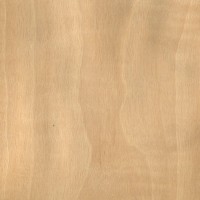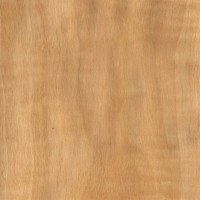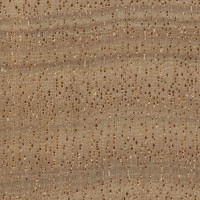 |
Common Name(s): Anigre, Anegre, Aniegre, Aningeria (and variant spellings) Scientific Name: Pouteria spp. (formerly Aningeria genus) Distribution: Africa (most common in tropical areas of east Africa) Tree Size: 100-180 ft (30-55 m) tall, 3-4 ft (1.0-1.2 m) trunk diameter Average Dried Weight: 34 lbs/ft3 (550 kg/m3) Specific Gravity (Basic, 12% MC): .44, .55 Janka Hardness: 990 lbf (4,380 N) Modulus of Rupture: 12,040 lbf/in2 (83.0 MPa) Elastic Modulus: 1,588,000 lbf/in2 (10.95 GPa) Crushing Strength: 6,920 lbf/in2 (47.7 MPa) Shrinkage: Radial: 3.8%, Tangential: 7.0%, Volumetric: 11.8%, T/R Ratio: 1.8 |
Color/Appearance: Heartwood is a light yellowish-brown, sometimes with a pinkish hue. Color tends to darken to a more golden brown with age. Pale sapwood is not well defined. Figured grain is occasionally present, such as curly or mottled grain.
Grain/Texture: Grain is straight to interlocked, with a medium uniform texture and a good natural luster.
Endgrain: Diffuse-porous; radial multiples of 2-4; medium pores in short radial rows, few; tyloses occasionally present; parenchyma reticulate; narrow rays, spacing normal to fairly close.
Rot Resistance: Rated as non-durable to perishable. Not resistant to insect attack. Sapwood susceptible to blue fungal staining during initial drying.
Workability: Overall working characteristics are fair, though depending on the species used, Anigre may have silica present and therefore have a blunting effect on tools.
Odor: Anigre is reported to have a faint odor similar to cedar.
Allergies/Toxicity: Besides the standard health risks associated with any type of wood dust, no further health reactions have been associated with Anigre. See the articles Wood Allergies and Toxicity and Wood Dust Safety for more information.
Pricing/Availability: Anigre is frequently sliced and sold as veneer, though solid boards are sometimes seen as well. Should be moderately priced for an imported hardwood.
Sustainability: Anigre is not listed in the CITES Appendices, but some species are reported by the IUCN as being conservation dependent. Cessation of any current conservation programs would likely result in a vulnerable or endangered Red List status.
Common Uses: Veneer, plywood and interior furniture; in board form it’s used for boatbuilding, general carpentry, and other light construction uses.
Comments: Formerly classified in the genus Aningeria, (in accordance with its namesake), Anigre is currently placed in the Pouteria genus, sometimes described as a “wastebasket taxon” where out-of-place genera are placed.
None available.
None available.








Is it a safe or non toxic wood in a dresser? I have had no luck in finding dressers that aren’t toxic or made with MDF and full of formaldehyde. I bought one nont knowing from Viet Nam and they took it back for I was sick from the fumes.
you need better visuals of what this wood can be, and commonly is: spectacularly figured, with fiddle-back/curl/bees-wing and/or razor mottle…..being a conglomeration of a few dozen species, it is variable in appearance/qualities, but tends to a very soft, easily damaged material, especially with todays 1/50″ veneer thickness….
I have anigre wood cabinets in a house we bought 7 years ago. Most of the veneer is smooth, but in a few sections the grain appears to be opening. It feels rough to the touch. What should I do?
How do you keep the wood from becoming dry? I moved into a house that has quite a few cabinets made of anigre that look like they might need some moisture
Unless the wood is splitting or cracked, it is probably fine. Wood doesn’t need extra moisture, and it will reach equilibrium with the surrounding air and won’t ever “dry out”.
Built a large china cabinet with this years ago. In the boards I used, the silica content was very high. No chance of using a bandsaw on this at all unless you splurge for the carbide tipped blades, but works pretty nicely with hand tools.
I built an acoustic guitar (back, sides, neck) out of some highly figured curly anigre. It sounds great and looks great. it takes a finish well. It can be a bit prone to cracking, so handle with care.